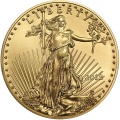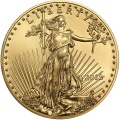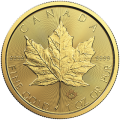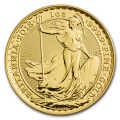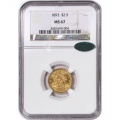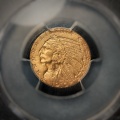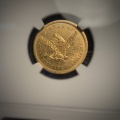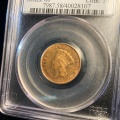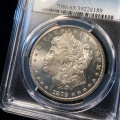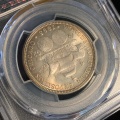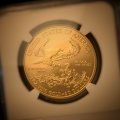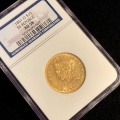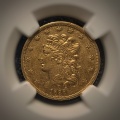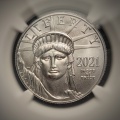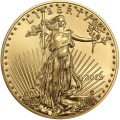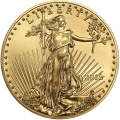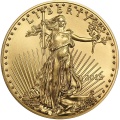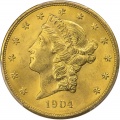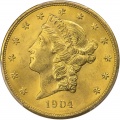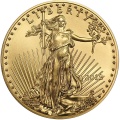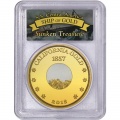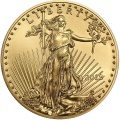April 2022 - Week 4 Edition
Gold Reacting to Volatile Market Conditions
Gold closed Friday at $1,950, April 22 but then fell Monday morning, partly on a stronger dollar, due to the European Central Bank’s insistence on leaving the euro’s rate near zero while the U.S. Federal Reserve is aggressively raising the dollar’s rates. The next meeting of the Federal Open Market Committee (FOMC) will be May 3-4, when they are expected to raise rates by 0.50%. Gold traded at its lowest price in two months early Monday, briefly falling below $1,900 after touching $2,000 a week earlier.
Times of Major Uncertainty Like This are Good for Gold…and Bad for Stocks
Despite gold’s temporary retreat on Monday, its performance, so far, this year has shown that times of uncertainty are good for gold and bad for stocks. The stock market fell 5% last Thursday and Friday with the tech-heavy NASDAQ falling over 6% in two days and over 20% from its peak. Friday was the worst market day in two years, and Monday opened down, with the Dow off over 2,000 points in three days, before rallying to close up for the day. As of last Friday, stocks have now fallen for four straight weeks.
Times of major uncertainty also drive rare coin prices higher. In the past 50 years, rare coins have surged between 348% to 1,195% three times, in 1972-74, 1976-80, 1986-90 and a smaller surge during the financial panic of 2008-09. Now, the PCGS 3000 rare coin index has begun another surge, rising over 21% in the last 12 months:
 Currently, pundits are blaming the stock market’s collapse on U.S. Federal Reserve Chairman Jerome Powell talking about a half-point increase in the Fed funds rate next week. The 10-year Treasury rate has already doubled from 1.5% to nearly 3% in the last few months, so he is merely playing “catch-up” with the one rate he controls. The bigger threats are fresh new concerns in the Biden era, like the war in Ukraine, China’s severe lockdowns in Shanghai, soaring inflation, ongoing supply chain constraints and our undefended borders, all resulting in super-low approval ratings of Biden’s policies and, frankly, his mental capacity.
Currently, pundits are blaming the stock market’s collapse on U.S. Federal Reserve Chairman Jerome Powell talking about a half-point increase in the Fed funds rate next week. The 10-year Treasury rate has already doubled from 1.5% to nearly 3% in the last few months, so he is merely playing “catch-up” with the one rate he controls. The bigger threats are fresh new concerns in the Biden era, like the war in Ukraine, China’s severe lockdowns in Shanghai, soaring inflation, ongoing supply chain constraints and our undefended borders, all resulting in super-low approval ratings of Biden’s policies and, frankly, his mental capacity.
These concerns are similar to what drove gold higher in 1972-74 during Nixon’s failed Presidency, with Vietnam and Watergate hanging over his head. Hyper-inflation and stagnation under Carter from 1978 to 1980, the Iran-Contra affair and the 1987 stock market crash, all drove rare coin prices sharply higher. The rare coin index rose 348% in 1972-74, 1,195% in 1976-80 and +665% in 1986-1990.
We are now just at the beginning of the next big surge, as exemplified by record gold ETF purchases in March, and increased U.S. Mint sales of gold bullion coins in the first quarter. As we know from decades of experience, when investors buy gold bullion for the first time, a significant percentage of those buyers see the added value of numismatic rarity and tend to graduate into rare coin purchases within 18-24 months.
Biden’s Political Mismanagement Will Likely Cost the Democrats Their Congressional Majority – and That’s Good for Gold
President Biden’s job approval ratings are currently the lowest ever for a President at this point in the four-year cycle. All four of his predecessors have lost Congressional control in the mid-term elections, three of them in their first term, so it’s fairly certain the Democrats will lose one or both houses of Congress in November. The current betting at FTX (where people bet real money) shows a 77% chance that Republicans will take over the Senate and an 85.8% chance the Republicans will take back the House.
This reversal has happened to each of the last four Presidents, and it was usually very good for gold:
- On November 7, 2006, Democrats took back a net six seats in the Senate and 31 seats in the House to retake control of both Houses of Congress from the Republicans under George W. Bush, as voters were seemingly tired of the endless wars and deficit spending under the once-cost-conscious (now spendthrift) Republicans. Gold was $625 an ounce on election day 2006, and it rose steadily to $834 a year later, up 33%, despite higher interest rates, courtesy of the Fed.
- On November 2, 2010, there was the most overwhelming reversal of power in any U.S. mid-term election – what Charles Krauthammer called a “restraining order on President Obama” – with the Republicans gaining 64 seats in the House, largely as a result of the new “Tea Party” movement. Gold was $1,351 per ounce on election day 2010, and it was $1,743 a year later, up 29%.
With all four of the last Presidents seeing their party’s control of Congress reversed in mid-term elections, it is likely Biden and the Democrats will face the same fate this November, and that will likely be good for gold, as its price soared an average 21% in the last four times such reversals occurred.

Important Disclosure Notification: All statements, opinions, pricing, and ideas herein are believed to be reliable, truthful and accurate to the best of the Publisher's knowledge at this time. They are not guaranteed in any way by anybody and are subject to change over time. The Publisher disclaims and is not liable for any claims or losses which may be incurred by third parties while relying on information published herein. Individuals should not look at this publication as giving finance or investment advice or information for their individual suitability. All readers are advised to independently verify all representations made herein or by its representatives for your individual suitability before making your investment or collecting decisions. Arbitration: This company strives to handle customer complaint issues directly with customer in an expeditious manner. In the event an amicable resolution cannot be reached, you agree to accept binding arbitration. Any dispute, controversy, claim or disagreement arising out of or relating to transactions between you and this company shall be resolved by binding arbitration pursuant to the Federal Arbitration Act and conducted in Beaumont, Jefferson County, Texas. It is understood that the parties waive any right to a jury trial. Judgment upon the award rendered by the Arbitrator may be entered in any court having jurisdiction thereof. Reproduction or quotation of this newsletter is prohibited without written permission of the Publisher.


